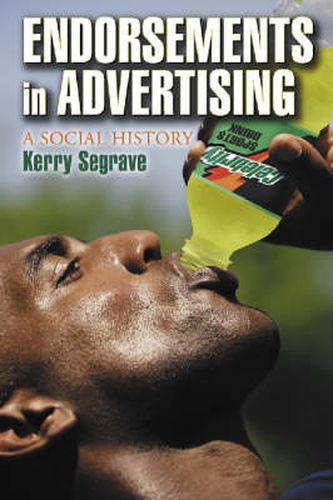Readings Newsletter
Become a Readings Member to make your shopping experience even easier.
Sign in or sign up for free!
You’re not far away from qualifying for FREE standard shipping within Australia
You’ve qualified for FREE standard shipping within Australia
The cart is loading…






This title is printed to order. This book may have been self-published. If so, we cannot guarantee the quality of the content. In the main most books will have gone through the editing process however some may not. We therefore suggest that you be aware of this before ordering this book. If in doubt check either the author or publisher’s details as we are unable to accept any returns unless they are faulty. Please contact us if you have any questions.
The use of endorsements and testimonials to sell anything imaginable is a modern development, though the technique is centuries old. Before World War I, endorsement ads were tied to patent medicine, and were left with a bad reputation when that industry was exposed as quackery. The reputation was well earned: claims of a product’s curative powers sometimes ran opposite the endorsee’s obituary, and Lillian Russell once testified that a certain compound had made her
feel like a new man.
Prohibition and drug regulation doomed patent medicines. Distrusted by the public, banished from mainstream publications, endorsements languished until the 1930s, but returned with a vengeance with the growth of consumerism and modern media. Despite its questionable effectiveness, endorsement advertising is now ubiquitous, costing advertisers (and consequently consumers) hundreds of millions of dollars annually. This exploration of modern endorsement advertising - paid or unsolicited testimonials endorsing a product - follows its evolution from a marginalized, mistrusted technique to a multibillion-dollar industry. Chapters recount endorsement advertising’s changing form and fortunes, from Lux Soap’s uncompensated co-opting of early Hollywood to today’s lucrative industry dependent largely on athletes. The social history of endorsement advertising is examined in terms of changing ethical and governmental views, shifting business trends, and its relationship to the growth of modern media, while the money involved and the question of effectiveness are scrutinized. The heavily illustrated text includes five appendices that focus on companies, celebrities, athletes and celebrity endorsements.
$9.00 standard shipping within Australia
FREE standard shipping within Australia for orders over $100.00
Express & International shipping calculated at checkout
Stock availability can be subject to change without notice. We recommend calling the shop or contacting our online team to check availability of low stock items. Please see our Shopping Online page for more details.
This title is printed to order. This book may have been self-published. If so, we cannot guarantee the quality of the content. In the main most books will have gone through the editing process however some may not. We therefore suggest that you be aware of this before ordering this book. If in doubt check either the author or publisher’s details as we are unable to accept any returns unless they are faulty. Please contact us if you have any questions.
The use of endorsements and testimonials to sell anything imaginable is a modern development, though the technique is centuries old. Before World War I, endorsement ads were tied to patent medicine, and were left with a bad reputation when that industry was exposed as quackery. The reputation was well earned: claims of a product’s curative powers sometimes ran opposite the endorsee’s obituary, and Lillian Russell once testified that a certain compound had made her
feel like a new man.
Prohibition and drug regulation doomed patent medicines. Distrusted by the public, banished from mainstream publications, endorsements languished until the 1930s, but returned with a vengeance with the growth of consumerism and modern media. Despite its questionable effectiveness, endorsement advertising is now ubiquitous, costing advertisers (and consequently consumers) hundreds of millions of dollars annually. This exploration of modern endorsement advertising - paid or unsolicited testimonials endorsing a product - follows its evolution from a marginalized, mistrusted technique to a multibillion-dollar industry. Chapters recount endorsement advertising’s changing form and fortunes, from Lux Soap’s uncompensated co-opting of early Hollywood to today’s lucrative industry dependent largely on athletes. The social history of endorsement advertising is examined in terms of changing ethical and governmental views, shifting business trends, and its relationship to the growth of modern media, while the money involved and the question of effectiveness are scrutinized. The heavily illustrated text includes five appendices that focus on companies, celebrities, athletes and celebrity endorsements.